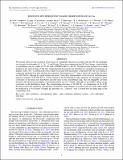Files in this item
Resolved multifrequency radio observations of GG Tau
Item metadata
| dc.contributor.author | Andrews, S.M. | |
| dc.contributor.author | Chandler, C.J. | |
| dc.contributor.author | Isella, A. | |
| dc.contributor.author | Birnstiel, T. | |
| dc.contributor.author | Rosenfeld, K.A. | |
| dc.contributor.author | Wilner, D.J. | |
| dc.contributor.author | Pérez, L.M. | |
| dc.contributor.author | Ricci, L. | |
| dc.contributor.author | Carpenter, J.M. | |
| dc.contributor.author | Calvet, N. | |
| dc.contributor.author | Corder, S.A. | |
| dc.contributor.author | Deller, A.T. | |
| dc.contributor.author | Dullemond, C.P. | |
| dc.contributor.author | Greaves, J.S. | |
| dc.contributor.author | Harris, R.J. | |
| dc.contributor.author | Henning, T. | |
| dc.contributor.author | Kwon, W. | |
| dc.contributor.author | Lazio, J. | |
| dc.contributor.author | Linz, H. | |
| dc.contributor.author | Mundy, L.G. | |
| dc.contributor.author | Sargent, A.I. | |
| dc.contributor.author | Storm, S. | |
| dc.contributor.author | Testi, L. | |
| dc.date.accessioned | 2014-08-29T12:01:02Z | |
| dc.date.available | 2014-08-29T12:01:02Z | |
| dc.date.issued | 2014-06-01 | |
| dc.identifier | 144261449 | |
| dc.identifier | 71c0e51e-421b-4406-96dc-742434b5d5cd | |
| dc.identifier | 84901020987 | |
| dc.identifier | 000336246700053 | |
| dc.identifier.citation | Andrews , S M , Chandler , C J , Isella , A , Birnstiel , T , Rosenfeld , K A , Wilner , D J , Pérez , L M , Ricci , L , Carpenter , J M , Calvet , N , Corder , S A , Deller , A T , Dullemond , C P , Greaves , J S , Harris , R J , Henning , T , Kwon , W , Lazio , J , Linz , H , Mundy , L G , Sargent , A I , Storm , S & Testi , L 2014 , ' Resolved multifrequency radio observations of GG Tau ' , Astrophysical Journal , vol. 787 , no. 2 . https://doi.org/10.1088/0004-637X/787/2/148 | en |
| dc.identifier.issn | 0004-637X | |
| dc.identifier.uri | https://hdl.handle.net/10023/5295 | |
| dc.description | S.M.A. and T.B. acknowledge support from NASA Origins of Solar Systems grant NNX12AJ04G. A.I., L.M.P., and J.M.C. acknowledge support from NSF award AST-1109334. | en |
| dc.description.abstract | We present subarcsecond resolution observations of continuum emission associated with the GG Tau quadruple star system at wavelengths of 1.3, 2.8, 7.3, and 50 mm. These data confirm that the GG Tau A binary is encircled by a circumbinary ring at a radius of 235 AU with a FWHM width of ∼60 AU. We find no clear evidence for a radial gradient in the spectral shape of the ring, suggesting that the particle size distribution is spatially homogeneous on angular scales ≳0.″1. A central point source, likely associated with the primary component (GG Tau Aa), exhibits a composite spectrum from dust and free-free emission. Faint emission at 7.3 mm is observed toward the low-mass star GG Tau Ba, although its origin remains uncertain. Using these measurements of the resolved, multifrequency emission structure of the GG Tau A system, models of the far-infrared to radio spectrum are developed to place constraints on the grain size distribution and dust mass in the circumbinary ring. The non-negligible curvature present in the ring spectrum implies a maximum particle size of 1-10 mm, although we are unable to place strong constraints on the distribution shape. The corresponding dust mass is 30-300 M⊕ , at a temperature of 20-30 K. We discuss how this significant concentration of relatively large particles in a narrow ring at a large radius might be produced in a local region of higher gas pressures (i.e., a particle "trap") located near the inner edge of the circumbinary disk. | |
| dc.format.extent | 12 | |
| dc.format.extent | 886923 | |
| dc.language.iso | eng | |
| dc.relation.ispartof | Astrophysical Journal | en |
| dc.subject | Dust, extinction | en |
| dc.subject | Protoplanetary disks | en |
| dc.subject | Radio continuum: planetary systems | en |
| dc.subject | Stars: individual (GG Tau) | en |
| dc.subject | QB Astronomy | en |
| dc.subject.lcc | QB | en |
| dc.title | Resolved multifrequency radio observations of GG Tau | en |
| dc.type | Journal article | en |
| dc.contributor.sponsor | Science & Technology Facilities Council | en |
| dc.contributor.institution | University of St Andrews. School of Physics and Astronomy | en |
| dc.identifier.doi | 10.1088/0004-637X/787/2/148 | |
| dc.description.status | Peer reviewed | en |
| dc.identifier.grantnumber | ST/J001651/1 | en |
This item appears in the following Collection(s)
Items in the St Andrews Research Repository are protected by copyright, with all rights reserved, unless otherwise indicated.

